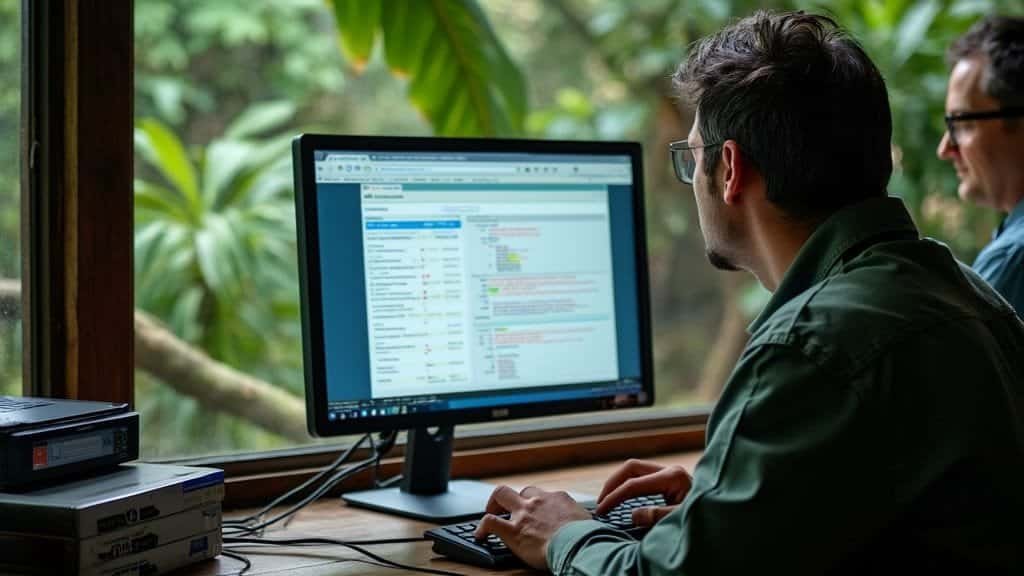Introduction
Maintaining the genetic diversity of red pandas in captivity is critical to ensuring the long-term health and sustainability of the species. With their populations in the wild dwindling due to habitat loss, zoos worldwide play an important role in conserving red pandas through coordinated breeding programs
These programs aim to preserve genetic diversity, prevent inbreeding, and ensure healthy future generations of red pandas. By using advanced genetic monitoring tools, international partnerships, and data-driven breeding strategies, zoos work to maintain diverse and resilient captive populations
This article explores the key strategies zoos use to manage the genetic diversity of red pandas in captivity and how global cooperation strengthens conservation efforts
Strategies Zoos Use to Maintain Red Panda Genetic Diversity
Zoos around the world play a vital role in preserving the genetic diversity of red pandas in captivity. Maintaining a healthy genetic pool is essential to prevent inbreeding and ensure the survival of the species, especially given the limited number of red pandas both in the wild and in captivity
To achieve this, zoos rely on a range of strategies, from carefully coordinated breeding programs to the use of genetic monitoring tools that track each red panda’s lineage
Coordinated Breeding Programs
One of the primary strategies zoos use to maintain genetic diversity in red pandas is through coordinated breeding programs. These programs involve selecting red pandas for breeding based on their genetic profiles to ensure that diverse genes are passed on to future generations
Many zoos participate in international initiatives like the Species Survival Plan (SSP), which works to manage the breeding of endangered species across different institutions to maintain healthy populations
The SSP for red pandas is a collaborative effort that brings together zoos from different countries to share information about their captive red panda populations. This cooperative approach allows zoos to avoid breeding closely related individuals, which would otherwise increase the risk of genetic defects and inbreeding
Zoos can exchange red pandas to introduce new genetic material into their populations, ensuring that breeding pairs are genetically diverse and unrelated
The SSP regularly reviews the genetic health of captive red pandas and makes recommendations on which individuals should be bred. These decisions are based on a range of factors, including the genetic makeup of each red panda, their health, and the current needs of the overall population
This coordinated approach helps zoos maximize genetic diversity while preventing inbreeding and managing the limited number of red pandas in captivity
Avoiding Inbreeding Through Genetic Monitoring
Inbreeding is a major concern for any captive population, especially for a species like the red panda, which has relatively small population numbers in both the wild and in zoos
Zoos use genetic monitoring to track the ancestry of each red panda, ensuring that individuals selected for breeding are not too closely related. This helps reduce the risk of genetic defects and ensures a healthy, viable population for future generations
Genetic monitoring involves collecting detailed data on the family lines of red pandas and using this information to guide breeding decisions. Zoos maintain genetic records that document the lineage of every individual, which is then shared with other institutions participating in the breeding program. This collective database allows zoos to select mates that will maximize genetic diversity while minimizing the risk of inbreeding
By constantly monitoring the genetic health of their red pandas, zoos can identify individuals with rare or valuable genes that should be preserved in the population. These animals are given priority for breeding, ensuring that their unique genetic traits are passed on
This approach helps maintain a diverse gene pool, which is crucial for the long-term survival of the species in captivity
Managing Small Population Sizes in Captivity
Managing small populations poses additional challenges for zoos, as the risk of inbreeding increases when the number of available breeding pairs is limited
To address this, zoos carefully plan their breeding programs to avoid pairing individuals that are too closely related. In some cases, zoos may import red pandas from other institutions or countries to introduce new genetic material and reduce the likelihood of inbreeding
In addition to genetic monitoring, zoos often rely on advanced reproductive technologies such as artificial insemination to manage small populations. These techniques allow zoos to maximize the genetic diversity of their red panda populations, even when the number of available breeding pairs is limited
Artificial insemination can be particularly useful for introducing genes from individuals that are not physically present at the zoo, further reducing the risk of inbreeding and increasing the overall genetic diversity of the population
Managing small population sizes also requires long-term planning and coordination between institutions. Zoos work together to plan breeding strategies that will benefit the entire captive population, rather than focusing solely on the needs of individual zoos
This collaborative approach helps ensure that the genetic diversity of red pandas is maintained across the global zoo network, reducing the risks associated with small populations
Research by Hutchins and Reed (2015) highlights the importance of coordinated breeding efforts and genetic monitoring in maintaining the genetic diversity of red pandas in captivity. The study found that zoos that participate in international breeding programs like the SSP are more successful in maintaining diverse and genetically healthy populations
The Role of Global Breeding Programs in Red Panda Conservation
Global breeding programs play a critical role in maintaining the genetic diversity and overall health of red pandas in captivity
These programs are built on international cooperation, where zoos from around the world collaborate to share genetic information, exchange animals for breeding, and manage populations in a way that mirrors natural processes as closely as possible
Through these efforts, breeding programs aim to preserve the long-term viability of red panda populations while also supporting broader conservation goals
The Species Survival Plan (SSP) for Red Pandas
The Species Survival Plan (SSP) is one of the most important programs for ensuring the genetic diversity and health of captive red pandas
Overseen by the Association of Zoos and Aquariums (AZA), the SSP is designed to manage the breeding of endangered species like the red panda across a network of participating zoos and wildlife institutions. The goal of the SSP is to create a genetically diverse and sustainable population of red pandas that can support both conservation in captivity and, if necessary, reintroduction into the wild
The SSP works by analyzing the genetic makeup of the entire captive population of red pandas and making recommendations for breeding pairs that will maximize genetic diversity
Zoos participating in the SSP share information about the red pandas in their care, including their genetic profiles, health histories, and behavioral traits. This information is used to create a “master plan” that guides breeding decisions across all participating zoos
One of the main strategies used by the SSP is to prioritize breeding between individuals with low kinship coefficients, meaning they are not closely related. This helps to reduce the risk of inbreeding and ensures that rare or valuable genetic traits are preserved within the population
The SSP also works to ensure that the captive population of red pandas remains large enough to prevent genetic bottlenecks, which can occur when populations become too small to maintain healthy genetic diversity
By managing the global captive population as a single unit, the SSP ensures that red pandas bred in captivity are as genetically diverse as possible. This not only helps maintain the health of the population in zoos but also strengthens the potential for future conservation efforts, including the possibility of reintroducing captive-born red pandas into the wild if necessary
International Cooperation and Red Panda Exchange Programs
International cooperation is essential for maintaining the genetic diversity of red pandas in captivity. Zoos around the world collaborate to exchange red pandas as part of global breeding programs, ensuring that individuals with valuable genetic traits are able to breed with others outside their immediate geographic area
This exchange of animals helps to prevent inbreeding and introduces new genetic material into different zoo populations, which is critical for maintaining a healthy gene pool
Red panda exchange programs are carefully coordinated to ensure that the animals are paired with genetically compatible mates. Zoos participating in these programs rely on the SSP’s genetic data and breeding recommendations to guide their decisions
By moving red pandas between institutions, zoos can balance the genetic makeup of their populations, avoiding the risks that come with isolated breeding efforts
These exchanges are not limited to one region or country. Zoos in North America, Europe, and Asia all work together as part of a global effort to conserve the species. For example, a zoo in Europe may exchange a red panda with one in North America if it is determined that their genetic pairing will enhance diversity
This level of international cooperation helps to create a robust global population of red pandas that is genetically healthy and resilient
Furthermore, zoos involved in red panda exchange programs often share their knowledge and best practices, contributing to improvements in husbandry, veterinary care, and breeding techniques
This exchange of information is just as important as the exchange of animals, as it helps zoos improve their care and management of red pandas, ensuring better outcomes for the species
Success Stories from Global Red Panda Breeding Efforts
Global breeding programs for red pandas have seen significant successes, demonstrating the value of international cooperation in conservation. Zoos have successfully bred numerous red pandas through these coordinated efforts, and the resulting offspring have helped to maintain the genetic health of the captive population
Many of these breeding successes are the result of careful genetic planning and the use of advanced reproductive technologies that increase the chances of successful births
One notable success story comes from the Smithsonian National Zoo in Washington, D.C., which has been a leader in red panda conservation for decades. The zoo’s breeding efforts have contributed significantly to the global red panda population, with several successful births resulting from pairings recommended by the SSP
Similarly, the Tierpark Berlin in Germany has also played a key role in breeding red pandas, contributing to the overall genetic health of the European red panda population
These successes highlight the importance of ongoing collaboration between zoos and conservation organizations. By working together, these institutions can ensure that red pandas born in captivity have the genetic diversity needed to thrive and contribute to the long-term survival of the species
Global breeding programs also create opportunities for further research, enabling zoos to study red panda behavior, health, and reproductive biology in ways that can inform conservation efforts both in captivity and in the wild
Research by Steele (2020) points to the success of global breeding programs as a key factor in maintaining the genetic diversity of red pandas. The study found that international cooperation through programs like the SSP has significantly reduced inbreeding and improved the overall health of captive populations
The report concludes that global breeding efforts are essential for the survival of red pandas, especially as their wild populations continue to decline
Technology and Genetic Monitoring in Zoos
Technology plays an essential role in helping zoos maintain the genetic diversity of red pandas in captivity
Genetic monitoring and advanced tools allow zoos to track the lineage of each red panda, make informed breeding decisions, and avoid inbreeding, ensuring healthy, genetically diverse populations. By utilizing cutting-edge technology, zoos can carefully manage breeding programs and contribute to the long-term survival of the species
Genetic Databases for Tracking Red Panda Lineages
One of the primary tools used by zoos to manage the genetic diversity of red pandas is the use of comprehensive genetic databases
These databases store detailed information about each red panda’s ancestry, including their parents, siblings, offspring, and genetic health. Zoos rely on these databases to avoid breeding closely related individuals and to ensure that breeding pairs maximize genetic diversity
The most widely used genetic database is the Species360 Zoological Information Management System (ZIMS), a global platform that tracks the genetic data of thousands of species, including red pandas
ZIMS allows zoos worldwide to access up-to-date information on the genetic profiles of red pandas in captivity, facilitating collaboration and coordination in breeding programs. By sharing genetic data, zoos can avoid pairing individuals with similar genes and instead focus on breeding animals that will introduce new genetic traits into the population
ZIMS and similar systems play a crucial role in preventing inbreeding, which can lead to genetic defects and health problems. These databases help zoos maintain the genetic integrity of their red panda populations by identifying the best breeding matches and tracking the overall genetic diversity of the global captive population
Using DNA Testing to Guide Breeding Decisions
In addition to databases, zoos use DNA testing to better understand the genetic makeup of individual red pandas. DNA testing provides a more detailed look at an animal’s genetic health, including any potential risks for hereditary diseases or inbreeding
By analyzing DNA, zoos can make more informed decisions when selecting breeding pairs, ensuring that only healthy and genetically diverse individuals are chosen to reproduce
DNA testing can also reveal valuable information about an individual’s genetic uniqueness. For instance, a red panda with rare or underrepresented genes may be prioritized for breeding to ensure that those traits are passed on to future generations. This helps zoos preserve genetic diversity within the captive population and avoid the loss of important genetic traits
Zoos also use DNA testing to verify the parentage of red panda cubs, ensuring that accurate lineage records are maintained. This allows zoos to keep detailed and reliable genetic profiles for each red panda, which can then be used to guide future breeding decisions
By combining DNA testing with the genetic data stored in global databases, zoos can make precise and effective breeding choices that contribute to the overall health of the species
How Software Tools Help Manage Genetic Health
Advanced software tools are essential in managing the genetic health of captive red pandas. Programs like the Population Management (PopLink) software are specifically designed to help zoos analyze and track genetic diversity across their captive populations
These tools allow conservationists to run simulations, predict the genetic outcomes of potential pairings, and evaluate the long-term genetic health of red panda populations
PopLink and similar programs provide zoos with a range of data points to evaluate before making breeding decisions. These include genetic diversity scores, kinship coefficients, and inbreeding coefficients, all of which are used to determine the best possible pairings for maintaining a healthy gene pool
These tools also allow zoos to monitor trends in genetic diversity over time, helping them anticipate potential problems and adjust breeding strategies as needed
Through the use of software tools, zoos can simulate various breeding scenarios to ensure that the best outcomes are achieved for genetic diversity. This kind of predictive analysis helps zoos minimize the risks associated with inbreeding and ensures that their breeding programs are sustainable in the long term
Additionally, these tools help zoos track the genetic health of multiple populations across different institutions, facilitating international cooperation in breeding efforts
Technology not only enhances the ability of zoos to make informed decisions but also improves the accuracy and efficiency of breeding programs. The use of genetic databases, DNA testing, and advanced software ensures that zoos can effectively manage their red panda populations while maintaining high levels of genetic diversity
Research by Liu (2019) highlights the importance of technology in managing the genetic health of captive populations. The study found that zoos using advanced genetic tools were better able to prevent inbreeding and maintain higher levels of genetic diversity compared to those relying solely on traditional methods
The research emphasizes that technology is a crucial component in the successful management of red panda populations
Challenges in Maintaining Red Panda Genetic Diversity
Maintaining the genetic diversity of red pandas in captivity is a complex task that comes with numerous challenges. Zoos must manage limited population sizes, avoid inbreeding, and navigate logistical and international barriers to ensure healthy breeding programs
Despite the advancements in genetic monitoring and breeding strategies, these challenges highlight the difficulties zoos face in sustaining a genetically diverse and healthy population of red pandas
Limited Captive Population and Breeding Pairs
One of the primary challenges in maintaining genetic diversity in captive red pandas is the small size of the breeding population. With only a limited number of red pandas in zoos globally, finding genetically compatible pairs can be difficult
Many red pandas in captivity are already closely related, which increases the risk of inbreeding if careful breeding practices are not followed
The limited gene pool in captive populations also means that zoos must be strategic about which individuals they breed. Every breeding decision carries significant weight, as the small population size limits the number of opportunities to introduce new genetic traits
This makes it even more critical for zoos to use genetic databases and other tools to select breeding pairs that will maximize diversity and avoid perpetuating harmful genetic mutations
Additionally, the global population of red pandas in captivity remains relatively small compared to other endangered species, which further complicates efforts to maintain a diverse gene pool. Zoos need to carefully manage the existing population while also finding ways to expand it without compromising genetic diversity
The Risk of Inbreeding and How Zoos Prevent It
Inbreeding poses one of the greatest risks to maintaining a healthy red panda population in captivity. When individuals that are closely related breed, there is a higher likelihood of passing on harmful genetic mutations, which can lead to health problems, reduced fertility, and lower overall fitness in offspring
For species like the red panda, which already face limited population numbers, avoiding inbreeding is crucial to ensuring the survival of the species
To minimize the risk of inbreeding, zoos rely on genetic databases to track the ancestry of each red panda and ensure that breeding pairs are not closely related
However, with such a small population, finding unrelated pairs can be a challenge. Zoos must sometimes import red pandas from other institutions or countries to introduce new genetic material into their population
In some cases, advanced reproductive technologies like artificial insemination or embryo transfer are used to introduce new genes into the population without physically relocating animals. These techniques allow zoos to overcome the challenges of small population sizes and avoid the risks associated with inbreeding
However, these technologies are not without their own challenges, as they require specialized expertise and equipment, and the success rates can vary
Research by Smith (2018) found that the risk of inbreeding in small captive populations is a significant concern for red panda conservation. The study highlights the importance of genetic monitoring and international cooperation in preventing inbreeding and maintaining genetic diversity in captive populations
Overcoming Logistical and International Barriers
Zoos face logistical and international challenges when trying to maintain the genetic diversity of their red panda populations. One of the biggest hurdles is the need for international cooperation to exchange animals between institutions in different countries
While red panda breeding programs rely on exchanging individuals to prevent inbreeding and introduce new genetic material, moving animals across borders requires navigating complex legal and logistical processes
International laws and regulations governing the transport of endangered species, such as the Convention on International Trade in Endangered Species (CITES), add layers of complexity to the process. Zoos must comply with these regulations while ensuring that the animals are transported safely and without stress, which can be challenging given the long distances involved
In addition, differences in quarantine protocols and veterinary practices between countries can complicate the exchange of red pandas
Zoos must coordinate closely with regulatory authorities, veterinarians, and conservation organizations to ensure that the animals are healthy and properly cared for throughout the transfer process
Despite these challenges, international cooperation remains a critical component of red panda conservation. Zoos around the world work together to share genetic data, breeding recommendations, and best practices, ensuring that captive populations remain genetically healthy
Overcoming logistical and legal barriers is essential for the long-term success of these breeding programs, and zoos continue to innovate and find solutions to facilitate the exchange of animals
Addressing the Impact of Small Populations on Genetic Diversity
Managing small populations in captivity requires long-term planning and careful coordination between zoos. Even with the best genetic monitoring tools, small populations are at risk of genetic bottlenecks, which occur when the gene pool becomes too limited to sustain healthy diversity
A genetic bottleneck can result in a decline in population health and resilience, making the animals more vulnerable to disease, reproductive challenges, and environmental changes
To address this, zoos must take proactive steps to increase the size of their captive red panda populations while maintaining genetic diversity. This may involve importing animals from other regions or zoos, implementing advanced reproductive technologies, or even considering the reintroduction of captive-born red pandas into the wild to bolster genetic diversity in wild populations
Another approach is to create “genetic reservoirs” by preserving the genetic material of red pandas through methods such as sperm or egg freezing
These genetic banks can serve as a backup resource for future breeding efforts, allowing zoos to preserve genetic diversity even if the captive population faces significant challenges
Research by Hutchins and Reed (2015) highlights the need for zoos to address the challenges posed by small populations through innovative approaches and international collaboration. The study emphasizes that maintaining genetic diversity in small populations requires a combination of careful management, technology, and cooperation between institutions
Conclusion
Maintaining the genetic diversity of red pandas in captivity is essential for the long-term survival of the species, and zoos play a critical role in this process. Through coordinated breeding programs, international cooperation, and advanced genetic monitoring tools, zoos work to ensure that red pandas in captivity remain healthy and genetically diverse
Programs like the Species Survival Plan (SSP) facilitate collaboration between zoos worldwide, allowing for the exchange of red pandas and the sharing of genetic data to prevent inbreeding and preserve rare genetic traits
However, challenges such as small captive populations, logistical barriers, and the risk of inbreeding highlight the complexities of managing red panda populations in zoos. To address these challenges, zoos rely on technology, such as genetic databases and DNA testing, to track the lineage of red pandas and make informed breeding decisions
Additionally, international partnerships and the use of advanced reproductive technologies help zoos overcome the limitations of small populations and ensure the continued health of their red pandas
Despite these challenges, zoos have made significant progress in maintaining genetic diversity in red pandas, contributing to the species’ conservation both in captivity and in the wild. As global breeding efforts continue to evolve, zoos will remain at the forefront of red panda conservation, ensuring that this endangered species has a chance for a brighter future









